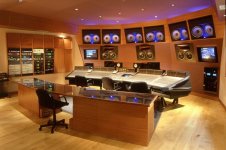There's a bunch of math on this thread that is way above my pay grade. Subsequently, there's a lot I don't understand.
(1) There's very little 'musical' below 40hz. I doubt you'd be able to recognise minor distortion in the fundamental, more so in the overtones which are, in the main, handle by other drivers.
(2) Isn't cone excursion affected by port tuning frequency?
(3) Isn't the relationship between SPL and cone excursion a little confusing? Crank up the volume, play the lead-in on a slightly warped vinyl. With no audible sound your drivers will readily hit Xmax.
(4) For a given size driver, isn't the driver with the larger Xmax is less efficient due to its reduced cone size?
It's probably not related to pay grade. Probably wordiness. I find visual explanations can help assist with the written one.
Stay tuned, hopefully next week I will be write a post and use some visual explanations to help elucidate...
Last edited:
I am really glad to discover these results. I have used XLS drivers in a number of projects. Especially 2x10" XLS 830452 as woofers in a 3-way music (not HT) system. A principal attraction is that they can perform with acceptably low distortion up to 200 Hz. This makes them simple to use with a superior mid-range while keeping the mid-range in its safe dissipation range. Very nice. 👍Pity they are no longer available.
People like Sigfried Linktwitz and John Krevskoksy have been using them for decades. Mark K also measured them.
Yes, I have also used the original 10 XLS- 830452. When I stepped away from DIY (due to lack of time) the XXLS and Dayton RSS were the best value. I was particularly interested in the 835016 (10" alu XXLS) but didn't have any projects needing them.
Other great (sub)woofers were available from TC Sounds, Acoustic Elegance, Eminence, and Audio Technology ($$$)
Carten Tinggaard really did a good job on the XXLS when he was at Peerless. But now that they are no longer available to DIYers in single quantities, the SB34RNXL-8 is a good alternative. It suited vented boxes, but distortion wise it doesn't really advance things compared to the XXLS or RSS series.
The SEAS L26ROY (2 layer version) or L26ROY3 (black cone) is perhaps the best 10" (sub)woofer currently on the market. To really advance subwoofer distortion you need to move to Purifi. The PTT10.0X will be better than the XXLS 12" in terms of distortion.
Either that, or go with a larger woofer and don't look back...
Last edited:
I try not to inappropriately imply ignorance on the part of others, but I have experienced that in most cases, with statements like these, the problem is lack of comparability due to other factors like frequency response and compression.
Fwiw, I can testify that ultra clean / highest fidelity bass, when properly set up and scaled, does not sound boring or underwhelming at all. My references include for example this system, which some years ago I had full access to: https://www.lambda-labs.com/en/references/wall-of-bass
I think you have not read what i wrote and what was implied relative to the genre/kind/style of music.
My reference include system implemented with something like that http://www.reyaudio.com/large-e.html
( RIS-1c)
And i might be ignorant maybe, but don't confuse the effect of loudly replayed low end with how it sound/feel despite i was playing things like that ( even produced some tune like this as a hobby) on big system outdoor regularly and compared to system shown up on daily basis in my job ( which was to record/mix 'real instruments' mainly):
So i can testify i stand with my statement and what it imply.
Last edited:
My reference include system implemented with something like that http://www.reyaudio.com/large-e.html
( RIS-1c)View attachment 1207007
..on big system outdoor regularly and compared to system shown up on daily basis in my job ...
The initial claim was, Post #33, in essence, "low distortion low end sounds disappointing initially with real instruments, but you'll notice more details eventually, and with electronic music it just sounds disappointing".
While of course that's a matter of subjective opinion, which there is no use arguing about, one can at least judge objectively if a speaker system is indeed suited for low distortion bass reproduction.
First, definition of "distortion" - there's
a) linear distortion - frequency dependent changes in amplitude in phase. Determined by speaker design / alignment, passive and/or active filters, environment / room.
b) nonlinear distortion - harmonic distortion, intermodulation distortion, ... Highly dependent, among other causes, on the excursion drivers of a given loudspeaker system have to perform for a certain SPL. Described in great detail by Klippel: https://www.klippel.de/fileadmin/klippel/Files/Know_How/Literature/Papers/Loudspeaker Nonlinearities_Causes,Parameters,Symptoms_06.pdf
The system I referenced is filtered to an essentially flat amplitude and phase response, with soft lower flank (-> low phase shift, low group delay), has no resonances / resonators, an enormous displacement leading to basically a complete absence of compression and nonlinear distortion at lower frequencies at any listening levels a human ear can tolerate, and is an SBA producing a cylindrical wave with no room interaction. It is as close to perfect bass reproduction as you can get.
Your reference is a bassreflex system. The Helmholtz resonator of a BR bass box has the transfer function of a PEQ - a peak with constant slopes to either side in amplitude, with a matching phase shift & group delay increase. The impact depends on the alignment (QB, SBB, SC, ...), but nevertheless, it is a compromise which always adds plenty of linear distortion.
Your picture shows quad 12 or 15" speakers with what looks like a 4in / 10cm diameter, maybe at best 6in / 15cm, port. That's somewhere roughly from 1/10th to 1/40th sd port surface area. Modern HiFi speakers tend to feature at least 1/4 sd, PA subwoofers 1/2 sd or more port surface area.
As has been long and well established, for example Maximizing Performance from Loudspeaker Ports - JBL, Infinity - AES, 2002, small port surface area adds compression, harmonic distortion, and turbulence / noise. That's a lot of added forms of distortion.
Your point about listening levels is valid. You don't need PA levels for a proper comparison. I'd say you need a minimum SPL level though for proper judgement of bass quality.. probably around normal average listening level, probably a little higher. And a level too high might be too overwhelming / physical for proper judgement.
Apart from that, I'm sure it wasn't your intentation, but you have made my point for me. The vast majority of those who claim that high fidelity = low distortion bass systems lack something, sound boring, underwhelming, whatever, have in fact never heard such a system. And the vast majority of them do not even have the understanding of what such a system would be.
You don't have to rent a club with a world record, reference PA, like I did, to gain that experience. A couple of high displacement CB woofers, outdoor, properly filtered, will do.
Note: horns will not do either, as they are quarter wave resonators, that, while by different physical mechanism, produce the exact same transfer function of the Helmholtz resonator, or a PEQ, and as such suffer from the same drawback.
Yeah I also looked at the hole in the picture with huge quad woofer box, it must be wine bottle holder 😀 It really looks too small for a port, it could work for one woofer but four, must be quite noisy if playing any louder.
edit. here is another photo, port is somewhat bigger but looks quite small still. Compare to the mains, there seems to be about as much port for one woofer. https://www.audioheritage.org/vbull...0daca671d6c567&p=318766&viewfull=1#post318766
Here is another: https://www.avforums.co.za/threads/...ita-infra-sonic-system-at-bop.4948/post-58848
mark100 installs proper low velocity ports on his 😉 https://www.diyaudio.com/community/threads/syn-11-a-one-horn-5-way.393087/post-7400021
edit. here is another photo, port is somewhat bigger but looks quite small still. Compare to the mains, there seems to be about as much port for one woofer. https://www.audioheritage.org/vbull...0daca671d6c567&p=318766&viewfull=1#post318766
Here is another: https://www.avforums.co.za/threads/...ita-infra-sonic-system-at-bop.4948/post-58848
mark100 installs proper low velocity ports on his 😉 https://www.diyaudio.com/community/threads/syn-11-a-one-horn-5-way.393087/post-7400021
Last edited:
These preconditions sound good 😀Let's ask a more simple question as well: Which 12" subwoofer driver would you choose for sub 80hz? Unlimited amp power, DSP and enclosure of up to 50L. Budget for driver maybe $300 but flexible because I want to see what you pick 😉
My choice - SB34NRXL75-8. Have a look: https://www.diyaudio.com/community/...rxl75-8-vs-sb29nrx75-6-vs-sb29nrx75-8.402671/
Money no problem - Purify 10". Would be interesting how such a chasis compares to a high end 12" ...
But their 8" already cost double of the SB 12". As always with HighEnd - quality doesn't scale linear with price.
That would also be my choice for a 50 l box, but 70 l would be better. Sealed, with about +9 dB 2nd order shelf at about 32 Hz. I think you could get F3 of 29 Hz.My choice - SB34NRXL75-8.
I think it is true of almost everything that humans make or build. A 10% increase in performance tends to cost twice as much.As always with HighEnd - quality doesn't scale linear with price.
55L, Fres = 43Hz, Qts = 0,65
I would give it maybe a 6dB shelf boost and then have a look what's happening in the room. Doesn't make sense to boost a lot just for room resonances.
I would give it maybe a 6dB shelf boost and then have a look what's happening in the room. Doesn't make sense to boost a lot just for room resonances.
Perhaps true... My suggestion was based on what I would need to replace my 70 liter SB34NRX75-6 with a 50 liter SB34NRXL75-8 and have the same 4pi anechoic response...
j.
j.
A.Let's ask a more simple question as well: Which 12" subwoofer driver would you choose for sub 80hz? Unlimited amp power, DSP and enclosure of up to 50L. Budget for driver maybe $300 but flexible because I want to see what you pick 😉
Another way to view the challenge is to pose the question as a design exercise-
1. Maximum cabinet approximately 50L (2 cu ft)
2. Baffle dimension size as… (determines the maximum woofer size)
3. Target- maximum output of the bottom two octaves (20-80Hz).
4. EQ to equalised for smoothest response at the listening position
Set budget fo driver as $300 retail…
B.
In case you missed it:
Here was a design with a different target- for maximum mid bass output (40+ Hz)
https://www.diyaudio.com/community/...stions-for-end-game-3-way.402411/post-7430675
Hope this serves to be useful to help understand design decisions and what compromises one may have to give up on.
Last edited:
In my experience when a woofer moves a large distance there is some sound generated by the flexing of the surround. In the past I found foam surrounds made more noise than the rubber surrounds. It is pretty revealing to just play a pure sinewave at 27.5 Hz (the lowest fundamental on the piano) and listen to it different levels up to Xmax. The pure sinewave is mostly felt and very quiet sounding and the source direction is difficult to determine. If there is noise from the surround or harmonic distortion, this is immediately audible as swishing sounds or the higher tones that the ear is more sensitive to. So two large woofers with lower excursion will often produce less extra surround noise and distortion than one woofer with twice the excursion. So if you have room for more boxes, that's the way to go. As the price of woofers tracks pretty linearly with the displacement, the two lower displacement woofers often cost the same as a single high displacement woofer. The added cost is the larger or second box.
This strongly depends on the chassis and how well it is made!
The SB34NRXL75-8 at the link above doesn't make any noise at all at >+-10mm (short video there). I use a 10 or 20Hz fundamental to be sure I only hear noises and THD, there are big differences in drivers for that. Especially cheaper, low Xmax drivers can be bad in this regard.
The SB34NRXL75-8 at the link above doesn't make any noise at all at >+-10mm (short video there). I use a 10 or 20Hz fundamental to be sure I only hear noises and THD, there are big differences in drivers for that. Especially cheaper, low Xmax drivers can be bad in this regard.
Yeah I also looked at the hole in the picture with huge quad woofer box, it must be wine bottle holder 😀 It really looks too small for a port, it could work for one woofer but four, must be quite noisy if playing any louder.
edit. here is another photo, port is somewhat bigger but looks quite small still. Compare to the mains, there seems to be about as much port for one woofer. https://www.audioheritage.org/vbull...0daca671d6c567&p=318766&viewfull=1#post318766
Here is another: https://www.avforums.co.za/threads/...ita-infra-sonic-system-at-bop.4948/post-58848
mark100 installs proper low velocity ports on his 😉 https://www.diyaudio.com/community/threads/syn-11-a-one-horn-5-way.393087/post-7400021
Kinoshita's are built to order, almost custom so i guess the picture i linked was for an audiophile customer not in need for high output, i don't know.
The one i heard had the wide port as in Bop studio pictures.
Mark make nice loudspeakers we all know. But with all deserved respect from my part he his not Shozo Kinoshita.
It seems you are not aware of who the guy is Tmuikku? I suggest you take a look at who he his and why he his known for ( as well as by who he have been endorsed, hint: founder of Westlake which changed for Kinoshita's in his multi million dollars control room's design when he first heard them... Yes the usual suspect from my side when talking about room acoustic: T.Hidley).
So for one time and with all due respect let me say this to you: if you have not heard them you should not comment on the technical choices made even if they seems strange or seems to go against physic ( as i was astonished by them too when i finally got the authorisation from studio owner to remove the screen which hidden them in the room i used them).
If you look at the use he made from his own horn design ( TD-4001) and drivers ( TH-4001) in his own design there is 'strange' approach too ( wrt what they offered under the 'consumer' brand TAD).
It's not a bad set of design constraints to focus on lowering sources of distortions.The initial claim was, Post #33, in essence, "low distortion low end sounds disappointing initially with real instruments, but you'll notice more details eventually, and with electronic music it just sounds disappointing".
While of course that's a matter of subjective opinion, which there is no use arguing about, one can at least judge objectively if a speaker system is indeed suited for low distortion bass reproduction.
First, definition of "distortion" - there's
a) linear distortion - frequency dependent changes in amplitude in phase. Determined by speaker design / alignment, passive and/or active filters, environment / room.
b) nonlinear distortion - harmonic distortion, intermodulation distortion, ... Highly dependent, among other causes, on the excursion drivers of a given loudspeaker system have to perform for a certain SPL. Described in great detail by Klippel: https://www.klippel.de/fileadmin/klippel/Files/Know_How/Literature/Papers/Loudspeaker Nonlinearities_Causes,Parameters,Symptoms_06.pdf
But does this distortions parameters you are focusing on are this important on the quality of rendering?
Research seems to be against your view:
http://www.gedlee.com/Papers/Distortion_AES_I.pdf
http://www.gedlee.com/Papers/Distortion_AES_II.pdf
And i would ask too if for LOW END is it even meaningfull from a psychoacoustic point of view? I've got my own idea as i worked on this on a regular basis in my former job (guess what... we often use distortion to make things have an 'appeal' at mix or master stage especially on lows) and can tell you human can withstand high level of distortion without them being even noticed on this register...
It's not difficult to try to convince yourself: get a DAW, some eq plug ins ( they most of them offer lowpass options) filter at between 80hz/250hz and put a distortion plug in in the next slot. Manipulate to taste and see by yourself.
That said i don't find it's a bad set of design constraint and have heard the effects i explained with systems like that. But i need to be pointed to source materials which have not been highpassed at 20hz and sometimes higher. Which makes the need for single digits for music... moot 99%. And as such low distortion there too. For an earthquake in a movie maybe there is a need so LFE territory but otherwise it's just to be sure the bandpass is extended enough to be clean on the required used extension range ( maybe exept if you are into Dubstep and listen to Bassnectar? Are you a fan Stoneeh?).
The system I referenced is filtered to an essentially flat amplitude and phase response, with soft lower flank (-> low phase shift, low group delay), has no resonances / resonators, an enormous displacement leading to basically a complete absence of compression and nonlinear distortion at lower frequencies at any listening levels a human ear can tolerate, and is an SBA producing a cylindrical wave with no room interaction. It is as close to perfect bass reproduction as you can get.
Woah. The perfect answer which solve all issue! Thanks to filters too! Lucky one the inventor of the thing: he managed to make the 'art of compromise' required to make an acceptable loudspeaker a thing of the past!
But why it's not usually globally accepted as the only answer and used everywhere from pro control rooms to domestic environnement? Because it doesn't fullfill some requirements of both... So it is an option along a multiple possible ones. As there is as much way to listen to things as they are listeners.
Your reference is a bassreflex system. The Helmholtz resonator of a BR bass box has the transfer function of a PEQ - a peak with constant slopes to either side in amplitude, with a matching phase shift & group delay increase. The impact depends on the alignment (QB, SBB, SC, ...), but nevertheless, it is a compromise which always adds plenty of linear distortion.
A compromise as everything in loudspeakers yes. Thank you explaining me the cons of BR, it's very kind of you. But maybe you know we have now tools which allow us to manipulate freq domain and time domain independantly and this 'filters' can help to mitigate the peq effect you talk about? As well as some alignement like EBS which have low group delay to boot on at first?
In other word even if my own preference are for sealed box with qtc of 0.577 ( for arbitrary reason of course) i don't buy this BS of reflex box all sounding the same with distinctive sound... i need double blind test comparison with 'well' implemented system of both kind to be convinced and i ask to point me to such research.
Results will be largely preference related if such thing exist, i bet.
Your picture shows quad 12 or 15" speakers with what looks like a 4in / 10cm diameter, maybe at best 6in / 15cm, port. That's somewhere roughly from 1/10th to 1/40th sd port surface area. Modern HiFi speakers tend to feature at least 1/4 sd, PA subwoofers 1/2 sd or more port surface area.
As has been long and well established, for example Maximizing Performance from Loudspeaker Ports - JBL, Infinity - AES, 2002, small port surface area adds compression, harmonic distortion, and turbulence / noise. That's a lot of added forms of distortion.
15" not 12", Tad drivers and mounted in a way to reduce second harmonic distortion by cancelation on an already benchmark driver for low harmonic distortion amongst HE drivers but more generally amongst drivers. For port size i won't repeat what i told to Tmuikku.
Your point about listening levels is valid. You don't need PA levels for a proper comparison. I'd say you need a minimum SPL level though for proper judgement of bass quality.. probably around normal average listening level, probably a little higher. And a level too high might be too overwhelming / physical for proper judgement.
No really my point is valid? Thank you but you don't teach me anything about level as to have a correct balance when working on audio it's one of the main point to understand.
But please tell me what is an average listening level, i'm genuinely interested?
The level produced by a string quartet? The one produced by a metal drummer? The one required by dj playing on huge soundsystem outdoor for huge crowd?
We ( pro in studio) have settled on some kind of norm (varying a bit from individuals to individuals and rooms but more or less around the same value of SPL for obvious reason. So obvious you'll tell me what they are?).
Apart from that, I'm sure it wasn't your intentation, but you have made my point for me. The vast majority of those who claim that high fidelity = low distortion bass systems lack something, sound boring, underwhelming, whatever, have in fact never heard such a system. And the vast majority of them do not even have the understanding of what such a system would be.
Yeah, you never heard the system i linked, don't even made the effort to read about the guy behind it and was able to down it on fire. And you make assumption without even knowing me... Let's say it's for the most laughable in my view.
But i don't know, maybe your a fanboy of the brand you linked ( which might do some very nice thing, don't take me wrong, i can't say as i've never heard it), or someone which like dogma as you seemed to be dishearted (to the point to make assumption on my part and be kinda aggressive) by a point of view which is not yours?
Anyway you doesn't seems to have read my comment or even understood what it implied...
I don't have distortion number to discuss as there is few system like that accessible as multi million dollars control rooms are not that often encountered and measurements made on them are usually well kept secrets. But i can tell you one thing: people investing this amount of money on a system wait for justification of money spent. And results.
Here you can read about the studio pictured in the link i gave about Kinoshita's Rm series loudspeakers, how they are implemented in there too:
https://www.avforums.co.za/threads/...ta-infra-sonic-system-at-bop.4948/#post-58848
And here a bit of history about the place:
https://www.soundonsound.com/music-business/bop-studios-story
I'm sure it'll confirm your suspicious on the stompbox distortion the sub can be! Lol.
The place i heard them wasn't in this range even if more or less based on same loudspeakers ( Rm6 in place of 7mesa) and not non environnement but Hidley's previous design. Despite differences comments made sound familiars to me.
If you want to have an idea of what to expect you could visit gearspace though, and see and discuss with some owner of this place, the numbers they gives to guide other or even the room designers and sometimes the loudspeaker's designers too ( not Kinoshita though).
You don't have to rent a club with a world record, reference PA, like I did, to gain that experience. A couple of high displacement CB woofers, outdoor, properly filtered, will do.
Note: horns will not do either, as they are quarter wave resonators, that, while by different physical mechanism, produce the exact same transfer function of the Helmholtz resonator, or a PEQ, and as such suffer from the same drawback.
Lol.
No they won't. Closed box have far too much thermal compression for outdoor P.A. use for electronic music like the one i linked, not even talking about the fact that after maybe one hour of play the glue keeping the driver's coil in place will melt down at required SPL levels... So when you need multiple days of continous play ( what?! Yes it happen...) this is a no-no. And i won't even talk about the number of box needed to approach well implemented BR or Horn or Tapped Horn...
But that you can only know if you do that kinda thing on a regular basis and knowing which style is played... which you don't seem to even mention for your test outdoor!
So to me you just prooved you don't really know what you talk about, at least about PA system and their requirements.
And the fact it seems there is definitive technical answers that only you seems to know and rejecting the possibility for other things to exist is just... scarying to me.
Don't feel obliged to ever answer this message or any of mine in the future, have a nice life, it was a pleasure to interact with you.
Last edited:
Hi,
yeah I have no knowledge on Kinoshita, or basically any other designer, and never heard such speaker system. It likely works fine for what it is, seems to be a serious system.
Found out RIS-1C bandwidth is mentioned to be 9-20Hz, internal volume seems to be something around 1000 litres. I don't know which drivers they are, found TAD TL-1601b specs from here http://www.hornstudio.de/1601b.pdf so using those to guestimate the speaker.
Plotting with VituixCAD enclosure tool using approximate of 1000l enclosure and 200cm2 port area and roughly 10Hz tuning, four TL1601b, the port length is modest around 50cm or so, not sure what the tuning should be so just questimating. If the port area is increased to 1000cm2 it would need to be several meters long for same tuning, so that's likely why it was chosen to be relatively small, it's more realistic. Port velocity drops as expected so seems that rules of the game are same for everyone 😉
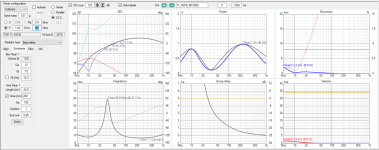
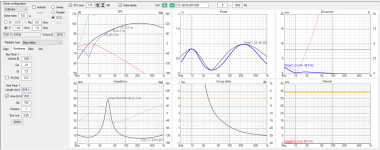
Also, playing with tuning frequency (length of the port keeping area the same), then it seems that higher tuning makes port velocity faster. Turbulence warning in VCAD with 200cm2 port, adjusting port length longer so that tuning goes lower, and port velocity seems to drop. Perhaps because it's below drivers resonance or something?

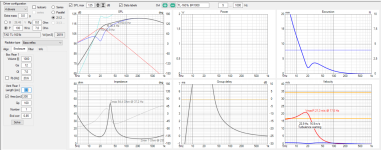
Then, using 1000 closed box the response is almost the same, even better on the infra frequencies, note the turquoise line on SPL graph which shows max SPL before xmax/power limit. Makes wonder why use port at all? So, perhaps they used different woofer, or modified one for this very special use case, or perhaps it is wine bottle holder?😀 Anyway, interesting stuff.
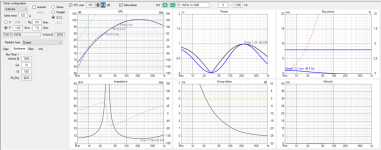
I wish I had a chance to listen legendary systems like these 🙂 They are most likely best what could be done back then, perhaps best that can be done today, optimized to specific application.
edit.
here is max output with reflex and closed. Reflex goes louder and turbulence warning is not reached. High pass filter is used to get max output around 10Hz on both. Reflex goes roughly 3db louder at 10Hz and perhaps port chuffing is not audible so it's not a wine bottle holder after all.
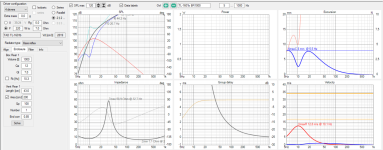
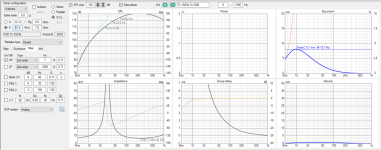
yeah I have no knowledge on Kinoshita, or basically any other designer, and never heard such speaker system. It likely works fine for what it is, seems to be a serious system.
Found out RIS-1C bandwidth is mentioned to be 9-20Hz, internal volume seems to be something around 1000 litres. I don't know which drivers they are, found TAD TL-1601b specs from here http://www.hornstudio.de/1601b.pdf so using those to guestimate the speaker.
Plotting with VituixCAD enclosure tool using approximate of 1000l enclosure and 200cm2 port area and roughly 10Hz tuning, four TL1601b, the port length is modest around 50cm or so, not sure what the tuning should be so just questimating. If the port area is increased to 1000cm2 it would need to be several meters long for same tuning, so that's likely why it was chosen to be relatively small, it's more realistic. Port velocity drops as expected so seems that rules of the game are same for everyone 😉


Also, playing with tuning frequency (length of the port keeping area the same), then it seems that higher tuning makes port velocity faster. Turbulence warning in VCAD with 200cm2 port, adjusting port length longer so that tuning goes lower, and port velocity seems to drop. Perhaps because it's below drivers resonance or something?


Then, using 1000 closed box the response is almost the same, even better on the infra frequencies, note the turquoise line on SPL graph which shows max SPL before xmax/power limit. Makes wonder why use port at all? So, perhaps they used different woofer, or modified one for this very special use case, or perhaps it is wine bottle holder?😀 Anyway, interesting stuff.

I wish I had a chance to listen legendary systems like these 🙂 They are most likely best what could be done back then, perhaps best that can be done today, optimized to specific application.
edit.
here is max output with reflex and closed. Reflex goes louder and turbulence warning is not reached. High pass filter is used to get max output around 10Hz on both. Reflex goes roughly 3db louder at 10Hz and perhaps port chuffing is not audible so it's not a wine bottle holder after all.


Last edited:
Playing around with the simulator it takes about 4x 15" drivers, or two 21" to reach 100db at 10Hz with a sealed box. Some modern drivers crammed into a 100litre enclosure can do it, but of course pouring in power.
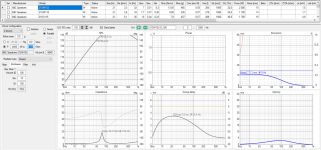
Then again on a 1000 litre ported enclosure even single 18" can do it, with great xmax though, likely more distortion with great excursion.
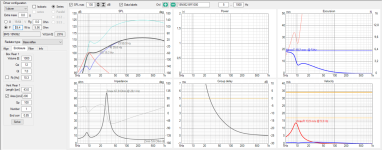
Perhaps there wasn't 18" drivers back in the day, perhaps the 15" they used was best that was available and that's what they used. Anyway, to reach 100db at ~10Hz it takes about 4x 15" woofers worth of volume displacement and about 1000litre box to have reasonable vent on it, so it's what needed to be done to reach such performance.

Then again on a 1000 litre ported enclosure even single 18" can do it, with great xmax though, likely more distortion with great excursion.

Perhaps there wasn't 18" drivers back in the day, perhaps the 15" they used was best that was available and that's what they used. Anyway, to reach 100db at ~10Hz it takes about 4x 15" woofers worth of volume displacement and about 1000litre box to have reasonable vent on it, so it's what needed to be done to reach such performance.
Last edited:
It's not a bad set of design constraints to focus on lowering sources of distortions.
But does this distortions parameters you are focusing on are this important on the quality of rendering?
Research seems to be against your view:
http://www.gedlee.com/Papers/Distortion_AES_I.pdf
http://www.gedlee.com/Papers/Distortion_AES_II.pdf
The first part of Geddes' paper is basically about harmonic distortion audibility / masking based on order(s) of the harmonic(s) and listening levels, which is well established knowledge; but, more importantly, as already explained, only one of many forms of distortion.
The second part attempts to establish a reproducable metric for audibility of nonlinear distortions, via various types of simulated combinations of harmonic and intermodulation distortion. Little to no practical application to our discussion, plus again ignores linear distortion.
Both parts also certainly don't contradict anything I was stating.
Also, you started your argument in this thread by making broad general statements about the audibility of distortions in low frequency reproduction, and in this post you suddenly start with "is it even important?". If so, then don't be the one to claim so in the first place.
You need to learn to be coherent.
we often use distortion to make things have an 'appeal' at mix or master stage especially on lows) and can tell you human can withstand high level of distortion without them being even noticed on this register...
Depends on what type of distortion, as for example the AES paper you just referred to showed.
Just for basic understanding, while various types of distortion are commonly used as art forms, this is up to the artist, including mastering - NOT the speaker, or any other part of the signal chain for that matter.
HiFi for example stands for "High Fidelity" - accurate acoustical reproduction of the electrical input signal.
Thanks to filters too!
Loudspeakers ARE filters.
A compromise as everything in loudspeakers yes. Thank you explaining me the cons of BR, it's very kind of you. But maybe you know we have now tools which allow us to manipulate freq domain and time domain independantly and this 'filters' can help to mitigate the peq effect you talk about? As well as some alignement like EBS which have low group delay to boot on at first?
Wait - didn't you just basically call filters evil? There's that coherence problem again.
Theoretically with FIR you should be able to get rid of the typical group delay peak of a BR, but you never mentioned you did or even attempted to do so. Correcting yourself after is not very believeable. Also, that still doesn't eliminate all of the types of distortion a BR design adds.
Low group delay / phase shift BR alignments suffer from larger amplitude shifts. Can't have the best of both worlds. Still plenty of linear distortion.
Closed box have far too much thermal compression for outdoor P.A. use for electronic music like the one i linked, not even talking about the fact that after maybe one hour of play the glue keeping the driver's coil in place will melt down at required SPL levels... So when you need multiple days of continous play ( what?! Yes it happen...) this is a no-no. And i won't even talk about the number of box needed to approach well implemented BR or Horn or Tapped Horn...
Thermal Simulation of Loudspeakers - Peter John Chapman, Bang & Olufsen, 1998, Fig. 19, shows the long term (3000s) warming, measured via sensor-in-voicecoil method, of a woofer in CB, playing music at its max. power handling capacity. There is little short term warming (on average +~20° C), and little to no long term warming trend either. So no, sorry, no melting coils.
Noone anywhere in this thread mentioned PA levels in listening tests intended to judge bass reproduction quality.
Data-Bass's Max. SPL list shows some very good results for long excursion CB woofers. A couple of high excursion 15"s, outdoor, properly filtered, like I recommended, will be more than adequate to provide low distortion (linear & nonlinear) bass reproduction at suited listening levels.
So to me you just prooved you don't really know what you talk about, at least about PA system and their requirements.
And the fact it seems there is definitive technical answers that only you seems to know and rejecting the possibility for other things to exist is just... scarying to me.
Don't feel obliged to ever answer this message or any of mine in the future, have a nice life, it was a pleasure to interact with you.
I will forego the very long list of system types, brands etc. I have owned and worked with, apart from the one reference system I named. If you can't conclude on your own that I must have had access to that system for a reason, and it was probably not the only one of its kind, not my problem.
Thing is, with the proper technical understanding, you don't need to chest-thump, and provide a long list of names and brands, Understanding the inherent working principle of a type of loudspeaker will reveal most of the relevent information.
Don't worry, I won't invest any more time. Thing is, I've been through this scenario many times. In very rare cases I receive gratitude and/or apologies from the side who got corrected. Most of the times, the response is similar to yours. People tend to prefer illusions over unpleasant truths. BUT, what I do notice consistently, that the other side will in the future rarely to ever repeat their mistakes. So, despite lack of admission, people do learn. That's at least worth my time, kind of.
Tmuikku,
Yes the drivers used are TL-1601 but i don't remember if they are B or A, anyway they are the same as the one used in the mains monitors RM series. We could ask @marco_gea i'm sure he knows it.
And he might have more technical info about RIS1C than i could ever give too, idk.
What was told to me by technical director of the place i used them was that port was there for acoustical reason but as in P.A to give a way for drivers to cool down as control room seen potential 2x12hours session a day 365/7 as for most commercial facility.
They were loaded by boundary too in that place: the concrete outer shell helped to bring SPL up and to make the transition to the lower limit of the RM-6 they were associated to. In a way the whole instal was described to me as if it was a three way system and not a 2way + subs. Xover was done actively with a custom analog processor on this one with JMF amps for mains ( remained stock passive xover for them) but i can't remember what was used for the subs ( i think the JMF amps wasn't used as they high passed too high or had been modded to allow larger bandpass).
About drivers size if i remember correctly TAD had one 18" availlable. But i think it was developed for 'The Eagles' sound system so more PA oriented. It might had given advantage about SPL but probably not about distortion on the 'restricted' box volume they ended up with (!) as Kinoshita choosen to use the 15" in push/pull. And not sure there is any real advantage to go past 130dbspl output capability even on heavily damped room as Hidley's one ( the only one i see is headroom still but even at 5 or 6 meter away you still have some marge allowed with 1kw amplifier...).
Now the sound... as i was still able to hear up to 20k @ 25years old i had some issues with the 12khz peak on the CD/horn combo. I already commented on that on many occasion in here. The other issue i had with the 15" TAD woofers is that there is something in them sounding 'cardboard' in the 600/800hz area and it is audible on the outcome. From the Warp monitors i heard ( and RM diy clone efforts with 15") i prefered the 12"carbon Davies drivers Kinoshita used in them: they sounded more 'hifi' to me. At least not 'cardboard' sounding ( especially on kickdrums).
For this particular room there was an issue about diffraction of soffitmounted monitors (an issue often related to previous to Non-Environnement Hidley's design) making the stereo scene width to 'dilate' as you pushed volume. It wasn't helped by the big reflector the AMS/Neve VR legend 60 is.
Bass, dynamic, micro details are flawless once used to their default and strength though. Great for acoustic recordings, whatever style ( done neo metal in there, a lot of Caribbean and African music, seen classical recorded as well as international 80's Hit makers bands - had access to original tapes of some legendary recordings in there, learned a lot from them 🙂 ).
As i had access to another room based on same driver family ( All Tad) with different acoustic design choice but largely inspired by Kinoshita's/Hidley's work ( same horn/cd combo but cut at 10khz to Et703, dual 12" horizontaly aligned + subs, so 4 way all inwall see attached photo) i am 99% sure of what i heard come from.
And yes it works, even if looking weird at first: Shozo Kinoshita know his business. Peoples still raves about his work 50 years later! Ask Docali or Fluid. 😉
And thank you for the sim @tmuikku, it gives some perspective about the technical choices made! Always great to see things verified.
Yes the drivers used are TL-1601 but i don't remember if they are B or A, anyway they are the same as the one used in the mains monitors RM series. We could ask @marco_gea i'm sure he knows it.
And he might have more technical info about RIS1C than i could ever give too, idk.
What was told to me by technical director of the place i used them was that port was there for acoustical reason but as in P.A to give a way for drivers to cool down as control room seen potential 2x12hours session a day 365/7 as for most commercial facility.
They were loaded by boundary too in that place: the concrete outer shell helped to bring SPL up and to make the transition to the lower limit of the RM-6 they were associated to. In a way the whole instal was described to me as if it was a three way system and not a 2way + subs. Xover was done actively with a custom analog processor on this one with JMF amps for mains ( remained stock passive xover for them) but i can't remember what was used for the subs ( i think the JMF amps wasn't used as they high passed too high or had been modded to allow larger bandpass).
About drivers size if i remember correctly TAD had one 18" availlable. But i think it was developed for 'The Eagles' sound system so more PA oriented. It might had given advantage about SPL but probably not about distortion on the 'restricted' box volume they ended up with (!) as Kinoshita choosen to use the 15" in push/pull. And not sure there is any real advantage to go past 130dbspl output capability even on heavily damped room as Hidley's one ( the only one i see is headroom still but even at 5 or 6 meter away you still have some marge allowed with 1kw amplifier...).
Now the sound... as i was still able to hear up to 20k @ 25years old i had some issues with the 12khz peak on the CD/horn combo. I already commented on that on many occasion in here. The other issue i had with the 15" TAD woofers is that there is something in them sounding 'cardboard' in the 600/800hz area and it is audible on the outcome. From the Warp monitors i heard ( and RM diy clone efforts with 15") i prefered the 12"carbon Davies drivers Kinoshita used in them: they sounded more 'hifi' to me. At least not 'cardboard' sounding ( especially on kickdrums).
For this particular room there was an issue about diffraction of soffitmounted monitors (an issue often related to previous to Non-Environnement Hidley's design) making the stereo scene width to 'dilate' as you pushed volume. It wasn't helped by the big reflector the AMS/Neve VR legend 60 is.
Bass, dynamic, micro details are flawless once used to their default and strength though. Great for acoustic recordings, whatever style ( done neo metal in there, a lot of Caribbean and African music, seen classical recorded as well as international 80's Hit makers bands - had access to original tapes of some legendary recordings in there, learned a lot from them 🙂 ).
As i had access to another room based on same driver family ( All Tad) with different acoustic design choice but largely inspired by Kinoshita's/Hidley's work ( same horn/cd combo but cut at 10khz to Et703, dual 12" horizontaly aligned + subs, so 4 way all inwall see attached photo) i am 99% sure of what i heard come from.
And yes it works, even if looking weird at first: Shozo Kinoshita know his business. Peoples still raves about his work 50 years later! Ask Docali or Fluid. 😉
And thank you for the sim @tmuikku, it gives some perspective about the technical choices made! Always great to see things verified.
Attachments
Last edited:
TL-1601b 🙂the drivers used are TL-1601 but i don't remember if they are B or A, anyway they are the same as the one used in the mains monitors RM series. We could ask @marco_gea i'm sure he knows it.
- Home
- Loudspeakers
- Multi-Way
- Subwoofer High xMax Distortion?
